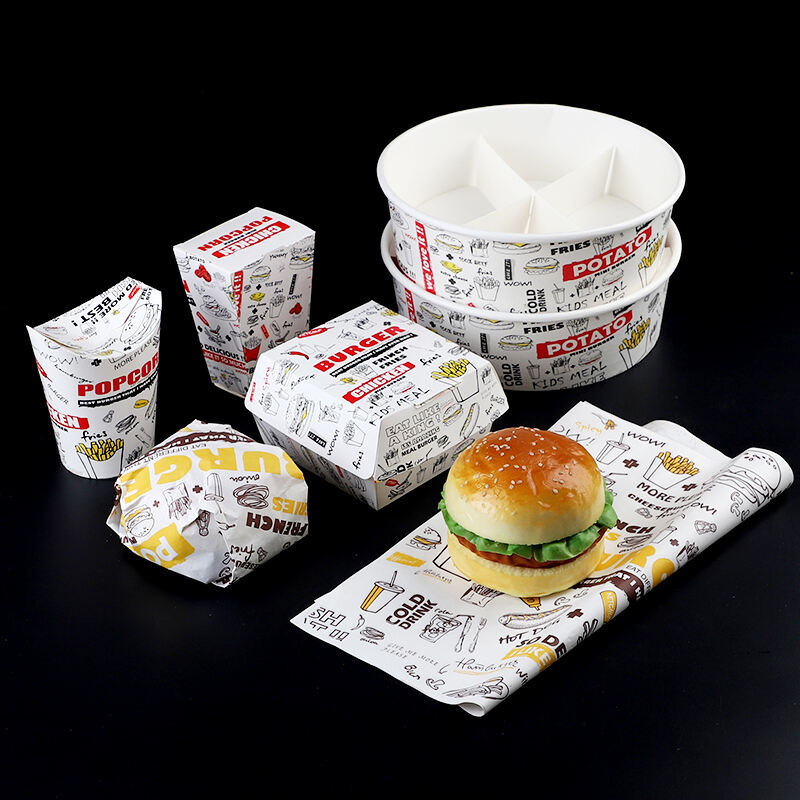Modernien pikaruokapakkausratkaisujen kehitys
Ala pikaruokapakkaus on kokenut merkittävän muodonmuutoksen viime vuosikymmeninä, mullistaen tapaamme nauttia suosituimmista pikaruokalistoista. Yksinkertaisista paperikääreistä moniosaisiin ja kehittyneisiin säilytysastioihin pikaruokapakkaus on jatkuvasti sopeutunut muuttuviin kuluttajatarpeisiin ja elämäntyylin vaatimuksiin. Tämä kehitys heijastaa syvempää ymmärrystä asiakkaan mukavuudesta, ympäristötietoisuudesta sekä parantuneen ruokailukokemuksen kasvavasta merkityksestä – ateriassa syödään sitten paikan päällä, mukaan otettuna tai kotiinkuljetettuna.
Nykyajan pikaruokapakkaus menee paljon pidemmälle kuin vain ruoan sisältämisen. Se toimii ratkaisevana kosketuspisteenä ravintoloiden ja asiakkaiden välillä, sisältäen innovatiivisia ominaisuuksia, jotka pitävät ruoan tuoreena, säilyttävät optimaalisen lämpötilan ja takaavat helpon käsittelyn. Kuluttajien odotusten noustessa ja ruokailutottumusten muuttuessa pakkausratkaisut ovat yhä kehittyneempiä, keskittyen sekä toiminnallisuuteen että käyttäjäkokemukseen.
Nykyisten pikaruokapakkausten suunnittelun keskeiset elementit
Ergonomiset suunnittelun piirteet
Moderni pikaruokapakkaus keskittyy käyttäjäystävällisiin suunnitteluelementteihin, jotka parantavat aterimisen kokemusta. Ergonomiset kahvat, helposti otettavat pinnat ja intuitiiviset avausmekanismit tekevät ruoan käsittelystä kätevämpää kuin koskaan aiemmin. Nämä suunnittelunäkökohdat ovat erityisen tärkeitä kuluttajille, jotka syövät matkalla tai matkustuksen aikana. Erityistä huomiota kiinnitetään vuotojen estämiseen ja ruoan eheyden ylläpitämiseen samalla kun sisältöön on helppo päästä käsiksi.
Edistyneet konttien muodot ja erikoistuneet lokit auttavat erottamaan eri ruokalajit toisistaan, estäen niiden sekoittumisen tai pehmittymisen. Tämä huolellinen järjestely varmistaa, että kuumat annokset pysyvät kuumina ja kylmät jäähdytettyinä, säilyttäen jokaisen osan tarkoitetun tekstuurin ja lämpötilan koko aterian ajan.
Lämpötilanhallintaratkaisut
Uudet materiaalit ja suunnittelutekniikat nopean ravinnon pakkauksissa tarjoavat nyt parempaa lämpötilan säätöä. Erityiset lämpöeristeet ja ilmanvaihtojärjestelmät auttavat ylläpitämään optimaalista ruoan lämpötilaa samalla kun estetään kosteuden tiivistyminen. Tämä teknologia varmistaa, että kuumat annokset pysyvät lämpiminä ja krokanseina, kun taas kylmät ainekset pysyvät tuoreina ja viileinä kuljetuksen aikana.
Viimeisimmät kehitykset lämpöä kestävissä materiaaleissa mahdollistavat paremman lämmön säilyttämisen rakennevakautta heikentämättä. Nämä edistymiset hyödyttävät erityisesti toimituspalveluita, joissa ruoan laadun ylläpito pidempien kuljetusaikojen aikana on ratkaisevan tärkeää asiakastyytyväisyyden kannalta.
Kestävät innovaatiot nopean ravinnon pakkauksissa
Ympäristöystävälliset materiaalivaihtoehdot
Fast food -ala käyttää yhä enemmän kestäviä pakkausratkaisuja vastatakseen kasvaviin ympäristöhuoliin. Hajoavat astiat, kierrätettävät materiaalit ja kompostoituvat vaihtoehdot ovat yleistyneet. Nämä ympäristöystävälliset vaihtoehdot tarjoavat saman tason käytännöllisyyden ja toiminnallisuuden, mutta vähentävät merkittävästi ympäristövaikutuksia.
Kasvipohjaiset pakkausmateriaalit, kuten bambu, sokeriruo'on kuitu ja maissitärkkelysperusteiset aineet, ovat yleistymässä. Näitä materiaaleja ei ainoastaan hajota luonnollisesti, vaan niiden valmistukseen kuluu usein vähemmän energiaa verrattuna perinteisiin pakkausvaihtoehtoihin. Monet fast food -ketjut toteuttavat nyt näitä kestäviä vaihtoehtoja osana ympäristövastuullisia toimintojaan.
Jätteen vähentämisteknologiat
Edistyneemmissä pakkauksissa on mukana jätteen vähentämiseen tähtääviä ominaisuuksia, jotka auttavat minimoimaan ympäristövaikutuksia tinkimättä käytännöllisyydestä. Älykkäät kokovalinnat vähentävät tarpeetonta pakkauksia, kun taas modulaariset suunnitteluratkaisut mahdollistavat tehokkaan varastoinnin ja kuljetuksen. Nämä innovaatiot auttavat ravintoloita optimoimaan pakkausten käyttöä samalla kun säilytetään ruoan laatu ja esitystavan standardit.
Joidenkin pakkauksien ratkaisuihin kuuluu nyt sisään rakennettuja annosohjausjärjestelmiä ja uudelleenkäytettäviä osia, jotka edistävät vastuullista kulutusta ja tarjoavat asiakkaille lisäarvoa. Näillä ominaisuuksilla tuetaan kasvavaa kuluttajatietoisuutta jätteen vähentämisestä ja ympäristön kestävyydestä.
Digitaalinen integraatio nykyaikaisessa pikaruokapakkausteknologiassa
Älykäs Pakkausteknologia
Digitaalisten elementtien integrointi pikaruokapakkauksiin edustaa merkittävää edistysaskelta asiakkaan mukavuudessa. QR-koodit, älykyltit ja NFC-tunnisteet mahdollistavat välittömän pääsyn ravintoarvoihin, lämmitysohjeisiin ja markkinointisisältöön. Nämä digitaaliset ominaisuudet parantavat asiakaskokemusta samalla kun tarjoavat arvokasta tietoa ravintoloille palveluidensa kehittämiseen.
Interaktiiviset pakkauskomponentit helpottavat myös saumattomia tilauskokemuksia, kannustusohjelmien integrointia ja reaaliaikaisen palautteen keruuta. Tämä digitaalinen yhteydenpito luo asiakkaille osallistavamman ja henkilökohtaisemman kokemuksen samalla kun auttaa ravintoloita ymmärtämään ja palvelemaan paremmin asiakaskuntaansa.
Seuranta- ja jäljituskäytännöt
Moderni pikaruokapakkaus sisältää usein jäljitysominaisuuksia, jotka mahdollistavat tilausten reaaliaikaisen seurannan. Nämä järjestelmät tarjoavat läpinäkyvyyttä toimitusprosessissa ja auttavat varmistamaan elintarviketurvallisuuden selkeän vastuuketjun ylläpitämisen kautta. Edistyneet jäljitysominaisuudet auttavat myös laadunvalvonnassa ja ravintoloita toimitusoperaatioiden optimoinnissa.
Lämpötilan seurantasensorien ja tuoreusindikaattorien integrointi antaa asiakkaille lisävarmuutta ruoan laadusta ja turvallisuudesta. Näitä ominaisuuksia erityisesti arvostetaan toimituspalveluissa, ja ne edistävät luottamuksen ylläpitoa ravintoloiden ja asiakkaidensa välillä.
Tulevaisuuden trendit pikaruokapakkausteknologiassa
Perustautuminen ja yksilöllistyminen
Pikaruokapakkauksien tulevaisuus on siirtymässä kohti lisääntynyttä personalisointia. Yksilöllisiin mieltymyksiin ja ruokavalintoihin vastaavat mukautuvat pakkausratkaisut yleistyvät. Näihin innovaatioihin kuuluvat muun muassa räätälöitävät lokit, annoskoon säätömahdollisuudet ja erityismateriaalit eri ruoka-aineille.
Edistyneet painoteknologiat mahdollistavat pakkausten joustavan räätälöinnin henkilökohtaisilla viesteillä, ravitsemustiedolla ja brändielementeillä. Tämä taso personalisointia auttaa luomaan osallistavampaa ja muistettavampaa aterimiskokemusta samalla kun otetaan huomioon asiakkaiden erityistarpeet.
Parannettuja toiminnallisuuksia
Uudet teknologiat tuovat pikaruokapakkausten käyttöön uusia toimintoja, kuten itsensä lämmittäviä elementtejä, jäähdytysmekanismeja ja tuoreuden säilyttäviä ominaisuuksia. Nämä innovaatiot pyrkivät pidentämään optimaalisen nauttimisajan ja parantamaan kokonaisvaltaista aterimiskokemusta. Älykkäitä materiaaleja, jotka reagoivat ympäristöolosuhteisiin, kehitetään paremman ruoanlaadun suojeluksi.
Tutkimus jatkuu pakkauksista, jotka soveltuvat erilaisiin syömisolosuhteisiin, kuten autokäyttöön sopivista ratkaisuista työtiloihin sopiviin säiliöihin. Kehitystyöt keskittyvät mukavuuden maksimointiin samalla kun säilytetään ruoan laatu ja turvallisuusvaatimukset.
Usein kysytyt kysymykset
Mikä tekee pikaruokapakkaamisesta ympäristöystävällistä?
Ympäristöystävällinen pikaruokapakkaus sisältää yleensä hajoavia materiaaleja, kierrätettäviä osia ja vähäisen jätemäärän suunnittelun. Keskeisiä ominaisuuksia ovat kasvipohjaiset materiaalit, kompostoituvat osat ja pienennetty pakkaustilavuus, samalla kun säilytetään täysi toiminnallisuus ja ruoansuojelu.
Kuinka älykäs pakkaus parantaa asiakaskokemusta?
Älykäs pakkaus parantaa asiakaskokemusta digitaalisilla integraatioominaisuuksilla, kuten QR-koodien, lämpötilan seurannalla ja reaaliaikaisella seurannalla. Nämä teknologiat tarjoavat helpomman pääsyn ravintoarvoihin, varmistavat ruoan laadun ja mahdollistavat vuorovaikutuksen brändin kanssa.
Mitä uusimmat innovaatiot ovat lämpötilan säädössä elintarvikkeiden pakkauksissa?
Uusimpiin lämpötilansäätöinnovaatioihin kuuluvat edistyneet lämpötekniset materiaalit, ilmanvaihtojärjestelmät ja älykkäät eristysteknologiat. Nämä kehitykset auttavat ylläpitämään optimaalista elintarvikkeiden lämpötilaa kuljetuksen ja varastoinnin aikana samalla kun estetään kondensoituminen ja säilytetään elintarvikkeiden rakenne.
Kuinka pakkauksia suunnitellaan parantamaan toimituspalvelujen tehokkuutta?
Nykyajan pikaruokapakkaukset sisältävät ominaisuuksia, jotka on erityisesti suunniteltu toimituspalveluita varten, kuten vuotonsuojat, kestävä rakenne ja tehokas pinottavuus. Nämä elementit yhdistettynä seurantateknologioihin ja lämpötilan ylläpitosysteemeihin takaavat, että ruoka saapuu perille optimaalisessa kunnossa.
Sisällys
- Modernien pikaruokapakkausratkaisujen kehitys
- Nykyisten pikaruokapakkausten suunnittelun keskeiset elementit
- Kestävät innovaatiot nopean ravinnon pakkauksissa
- Digitaalinen integraatio nykyaikaisessa pikaruokapakkausteknologiassa
- Tulevaisuuden trendit pikaruokapakkausteknologiassa
- Usein kysytyt kysymykset
